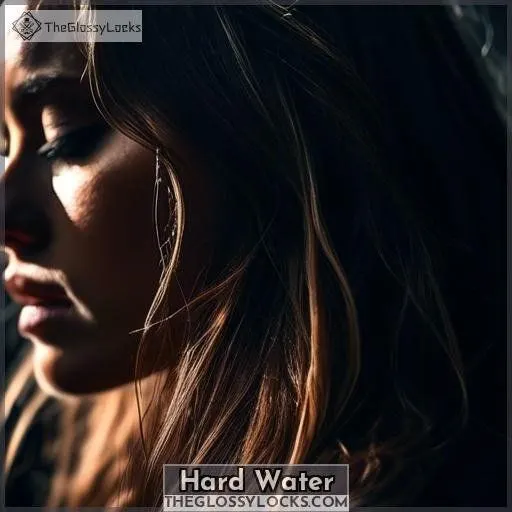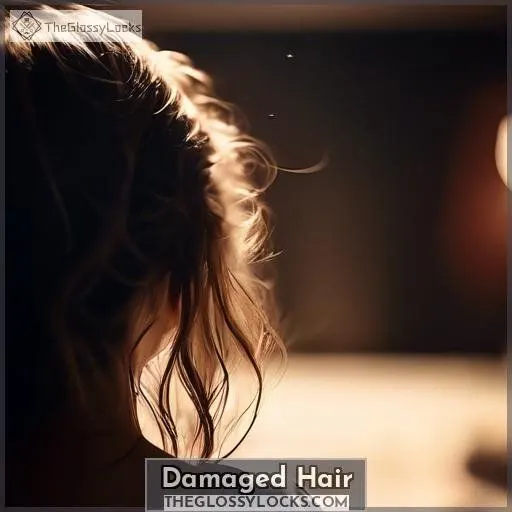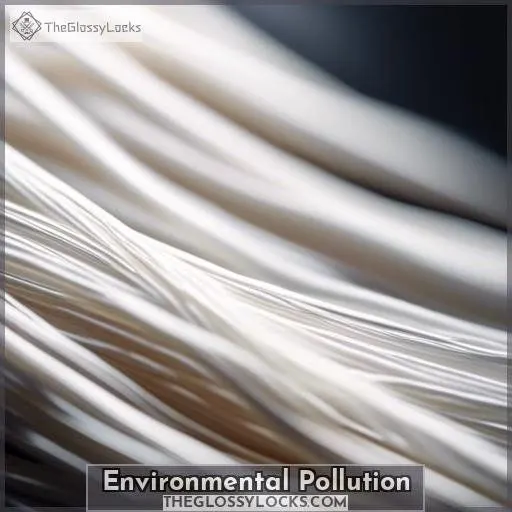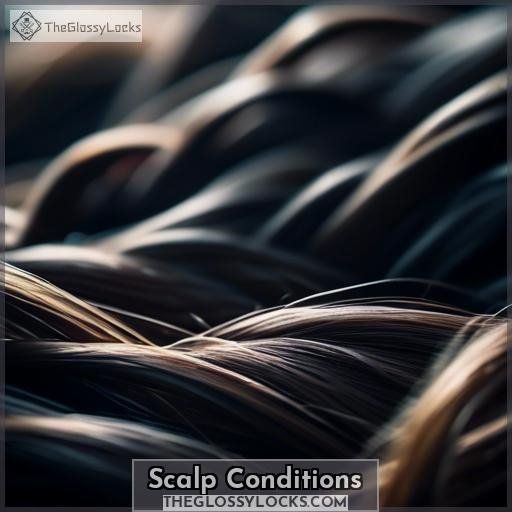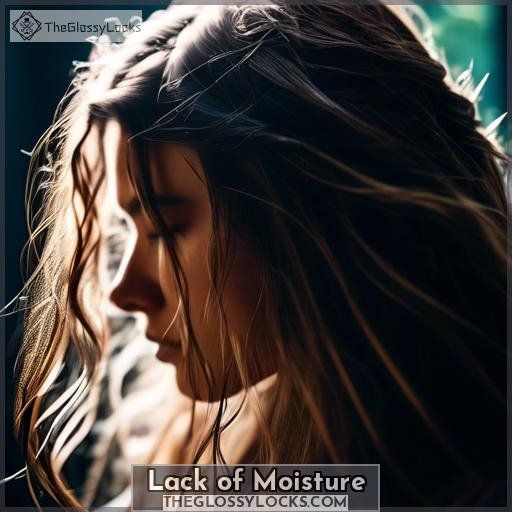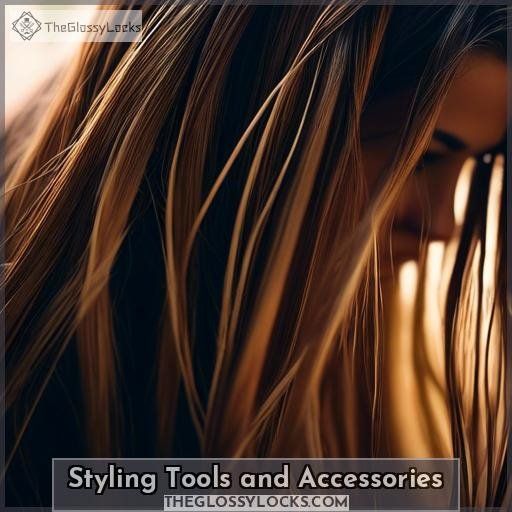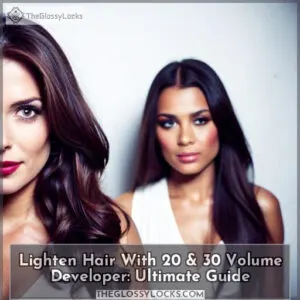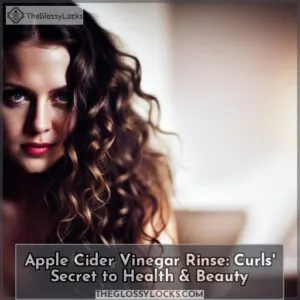This site is supported by our readers. We may earn a commission, at no cost to you, if you purchase through links.
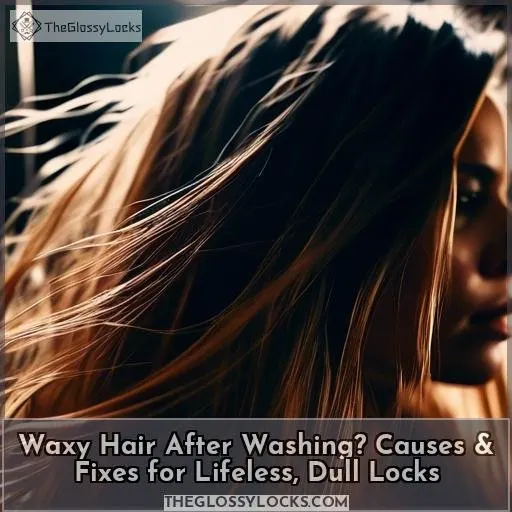
Your waxy hair after washing could be caused by hard water‘s high mineral content that coats strands, creating a dull, lifeless appearance.
Install a showerhead filter or use a water softener to remove minerals.
Chemical processing, heat styling, and product buildup can also roughen the cuticle, trapping oil and residue.
Avoid harsh shampoos and deep condition regularly.
Health issues like hormonal imbalances and medications may increase oil production too.
Consult a professional if scalp conditions persist.
You’ll find more underlying causes and solutions by continuing.
Table Of Contents
Key Takeaways
- Hard water can contribute to waxy hair by depositing minerals on the strands, creating a dull appearance.
- Chemical processing, heat styling, and product buildup can roughen the cuticle, trapping oil and residue.
- Health issues like hormonal imbalances and medications may increase oil production, leading to waxy hair.
- Regular deep conditioning, using sulfate-free shampoos, and maintaining a clean hairbrush can help prevent waxy hair.
Hard Water
You may notice your hair feeling waxy and lifeless after washing if you have hard water.
Hard water contains high mineral content.
Mineral deposits cling to your strands and create a dull, coated appearance.
To combat this issue, consider installing a showerhead filter.
Alternatively, use a water softener to remove these minerals before they can build up on your hair.
High Mineral Content in Water
Hard water can be a significant contributor to waxy hair. The high mineral content in hard water can create a buildup on your hair, making it appear dull and lifeless. This buildup can also cause your hair to feel heavy and weighed down, making it difficult to style. To prevent hard water from damaging your hair, consider the following tips:
- Install a water softener or showerhead filter to remove minerals from your water.
- Use a clarifying shampoo to help remove mineral build-up from your hair and scalp.
- Rinse your hair with bottled water when traveling or visiting a location with hard water.
- Use a vinegar rinse to help remove mineral build-up from your hair and scalp.
- Regularly deep condition your hair to help restore moisture and prevent dryness.
Use of Showerhead Filters or Water Softeners
Hard water buildup can contribute to waxy hair after washing.
Mineral deposits from the water can cling to hair and interact with hair products, leading to a waxy film.
To combat this, consider using a showerhead filter or water softener.
These can reduce mineral deposits and improve the effectiveness of your hair wash routine.
Regular upkeep of your showerhead and filters is also important for best performance.
Additionally, be aware that chlorine removal may be necessary in areas with high levels of chlorinated water.
Damaged Hair
Your hair may appear waxy and dull after washing due to chemical processing or heat damage that has compromised the cuticle layer. Using unclean brushes, hats, or harsh shampoos that strip your hair can further roughen the cuticles, causing them to trap oil and styling product residue.
Chemical Processing and Heat Damage
Just as hard water can leave your hair feeling like a waxy candle, chemical treatments and heat styling are notorious culprits for damage. Here’s a quick fix list:
- Dodge bleach damage by embracing your natural hue.
- Sidestep heat damage; let your locks air-dry.
- Shield your strands from sun damage; hats on!
- Say no to chemical relaxers; curls are cool!
Use of Unclean or Damaged Hairbrushes and Hats
Unclean or damaged hairbrushes can transfer oils to your hair, causing it to appear waxy. Regularly clean your hairbrushes with shampoo and warm water. If your hairbrushes are damaged, replace them with new ones. Avoid using damaged hairbrushes as they can cause more harm than good.
Use of Harsh Shampoos and Conditioners
Sulfate shampoos can be harsh on your hair, potentially stripping it of essential moisture and causing frizz.
If you’re prone to frizz, consider using sulfate-free shampoos with frizz-neutralizing ingredients like amphoteric or nonionic surfactants.
Alternatively, you can minimize the risks by using a sulfate shampoo that also has frizz-neutralizing ingredients.
For sensitive skin or hair, sulfate-free shampoos may be worth the investment, even though they’re more expensive than their conventional sulfate-containing counterparts.
Health Problems & Medications
You might be experiencing waxy hair after washing due to certain health problems or medications. Hormonal imbalances, skin conditions like seborrheic dermatitis, and drugs that increase oil production such as steroids, birth control pills, or blood thinners can lead to excess sebum secretion, causing waxy buildup and lifeless strands.
Hormonal Imbalances and Skin Conditions
Hormonal imbalances and skin conditions can lead to waxy hair. Some common issues include:
- Hormonal changes: Pregnancy, menopause, and thyroid problems can alter hair texture and oil production.
- Skin issues: Eczema, psoriasis, and acne can cause scalp inflammation, affecting hair health.
- PCOS: Polycystic ovary syndrome can cause hormonal fluctuations, leading to increased oil production and waxy hair.
To combat these issues, consider:
- Adjusting your hair care routine based on your skin type and hormonal changes.
- Using gentle, fragrance-free products to avoid irritation.
- Consulting a healthcare professional for personalized advice.
Medications That Increase Oil Production
Just as hormonal imbalances can leave your hair feeling less than fabulous, certain medications might be the secret culprits behind that unwelcome waxy buildup. Think of your medicine cabinet as a potential party crasher for your hair’s natural vibe. Medications like birth control, steroids, antihistamines, antidepressants, and chemotherapy can rev up your scalp’s oil production, turning your hair’s volume knob down to grease city.
| Medication Type | Effect on Hair |
|---|---|
| Birth Control | Increases oil |
| Steroids | Boosts greasiness |
| Antihistamines | Can dry out, paradoxically leading to more oil |
| Antidepressants | Might alter oil production |
| Chemotherapy | Unpredictable effects, often increases oil |
Stress and Anxiety
Stress and anxiety can also contribute to waxy hair. High cortisol secretion from stress hormones can increase oil production on your scalp, leading to waxy buildup. Anxiety levels can also cause scalp inflammation, disrupting the hair growth cycle. Here are four ways to combat stress-related waxy hair:
- Practice stress-reducing activities like meditation, yoga, or deep breathing exercises.
- Incorporate a balanced diet rich in vitamins and minerals that support hair health.
- Use hair care products specifically designed for stressed or damaged hair.
- Consider seeking professional help, such as therapy or counseling, to manage stress and anxiety.
Environmental Pollution
Environmental pollution exposes your hair to contaminants that cling to strands, creating a waxy film. Use air purifiers at home and install water filters to reduce airborne particles and remove impurities from shower water that contribute to waxy buildup.
Exposure to Air and Water Pollution
Exposure to air and water pollution can lead to waxy hair.
Pollution sources include transportation, power generation, and industrial activities.
These sources release harmful substances like nitrogen oxides, particulate matter, and volatile organic compounds (VOCs) into the air and water.
These pollutants can create a waxy film on the hair, making it appear dull and lifeless.
To prevent pollution-related waxy hair, it’s crucial to be aware of pollution sources and take steps to minimize exposure.
This may include using air purifiers and water filters, avoiding heavily polluted areas, and adhering to local pollution regulations.
Use of Air Purifiers and Water Filters
To improve your home’s air quality and prevent waxy hair, consider using air purifiers and water filters. Air purifiers can capture pollutants like smoke, pollen, and dust, while water filters can remove minerals and contaminants from your water supply. Here are some tips on how to choose the right air purifier and water filter for your needs:
- Air Purifier Selection: Look for an air purifier with a high-efficiency particulate air (HEPA) filter, which traps 99.97% of particles that are 0.3 microns or larger. Consider the size of your room and the air changes per hour (ACH) rate, which indicates how often the air purifier can exchange all the air in the room. Also, factor in the cost of filter replacements and ongoing maintenance.
- Water Filter Types: There are various types of water filters, including carbon filters, reverse osmosis systems, and UV filters. Carbon filters can remove chlorine and other contaminants, while reverse osmosis systems can remove minerals and dissolved solids. UV filters can kill bacteria and viruses. Choose a water filter that suits your specific water quality issues and your budget.
- Pollution Index Monitoring: Some air purifiers and water filters come with sensors that monitor the air and water quality in your home. This can help you adjust your settings and maintenance schedule accordingly.
- Home Air Quality Improvement: In addition to air purifiers and water filters, consider other ways to improve your home’s air quality, such as using air-filtering plants, maintaining your HVAC system, and avoiding harsh cleaning products.
- Water Softener Installation: If you have hard water, consider installing a water softener showerhead to reduce the mineral content and prevent buildup on your hair.
Scalp Conditions
Scalp conditions like dandruff and seborrheic dermatitis can contribute to waxy hair buildup. You may need to use antifungal treatments or homemade remedies like apple cider vinegar rinses to manage these conditions and prevent excess oil production.
Dandruff and Seborrheic Dermatitis
Keep your scalp clean and healthy to avoid waxy hair. Maintain scalp hygiene by exfoliating regularly to remove dead skin cells and prevent bacterial overgrowth. Natural remedies like apple cider vinegar and tea tree oil can help balance your scalp’s pH and reduce dandruff. For severe cases, consider using antifungal treatments prescribed by a healthcare professional.
Use of Antifungal Treatments and Homemade Remedies
Battling scalp conditions like a knight against dragons? Here’s your armor:
- Engage in antifungal treatments; they’re your sword against pesky dandruff.
- Whip up homemade remedies; think of them as your trusty shield.
- Embrace the quest for a balanced scalp; it’s your path to freedom.
- Remember, every warrior’s journey is unique; find your rhythm and conquer those dull, lifeless locks.
Lack of Moisture
You may experience waxy, dull hair after washing due to a lack of moisture and nourishment. Incorporate deep conditioning treatments and hair oils into your routine to replenish lost hydration and revive lifeless, parched strands.
Inadequate Hydration and Nourishment
Inadequate hydration and nourishment can lead to waxy hair.
To combat this, focus on product selection that caters to your hair type and scalp health.
Regular scalp exfoliation helps remove dead skin cells and buildup.
Nutrition plays a vital role; consume foods rich in vitamins and minerals for healthy hair.
Hair masks and home remedies can provide additional moisture and nourishment.
Use of Deep Conditioning Treatments and Hair Oils
If your hair remains greasy despite cleansing, it may stem from a deficit of moisture. Intensive conditioning treatments and hair oils can aid in replenishing hydration. Pre-washing treatments, leave-in masks, and thermal oil treatments are all effective options. Utilize them consistently to guarantee that your hair maintains its moisture and is devoid of greasy accumulation.
Improper Shampooing Technique
Improperly shampooing can lead to waxy hair. You’re not thoroughly saturating strands with shampoo, leaving residue behind. You’re also not rinsing out all shampoo suds, causing buildup. Double shampooing helps guarantee a complete cleanse – shampoo twice, rinsing fully after each application.
Not Saturating Hair With Shampoo
- Infrequent Washing: Not washing your hair enough can lead to buildup, which can weigh down your hair and make it appear waxy.
- Improper Rinsing: Failing to rinse shampoo suds completely can leave residue on your hair, giving it a waxy appearance.
- Double Shampooing: For thorough cleansing, it’s imperative to lather, rinse, and repeat, especially if you have fine, oily hair or use a lot of styling products.
To avoid these issues and maintain healthy, non-waxy hair, make sure you:
- Wet Your Hair Thoroughly: Stand under the shower stream for at least a full minute until every strand is drenched.
- Use the Right Amount of Shampoo: Stick to the coin method: a nickel for short hair, a quarter for medium hair, and a loonie for long hair.
- Massage Your Scalp: Scrub your scalp to remove sebum, oils, and product buildup.
- Rinse Thoroughly: Ensure all shampoo suds are removed before applying conditioner.
- Double Shampoo: For a deeper clean, lather, rinse, and repeat, especially if you have fine, oily hair or use a lot of styling products.
Not Rinsing Shampoo Suds Completely
Not rinsing shampoo suds completely can lead to waxy hair.
If you’re using heavy products or skipping a double wash, your hair may not get the thorough cleansing it needs.
Incorrect conditioner application, such as applying it directly to your scalp or using heavy ingredients, can also contribute to the problem.
To fix this, make sure you rinse your shampoo thoroughly before applying conditioner.
Avoid using too many styling products.
Double Shampooing for Thorough Cleansing
Don’t just lather and rinse – double down on cleansing! Start with a dollop of shampoo, work it into a rich foam, then repeat for a deep clean. Massage your scalp to dislodge gunk, and finish with a rejuvenating apple cider vinegar rinse. The right product selection and water temperature make all the difference in banishing waxy buildup.
Styling Tools and Accessories
You may be unwittingly contributing to your waxy hair woes through the use of hot styling tools and accessories. These instruments can leave behind residue, product buildup, and even singe and damage your strands, leading to a lifeless, waxy appearance.
Use of Hot Styling Tools and Hair Ties
Hot styling tools and hair ties can contribute to waxy hair by causing damage and buildup. To avoid this, use a heat protectant spray before styling, and be gentle when removing hair ties to prevent breakage. Additionally, clean your styling tools regularly to prevent product buildup.
Cleaning and Maintaining Styling Tools and Accessories
Don’t let dirty styling tools and accessories contribute to your waxy hair. Regularly clean your hair ties, brushes, and other accessories to prevent product buildup. Here’s how:
- Wash hair ties in warm soapy water.
- Disinfect brushes with a mixture of water and tea tree oil.
- Clean combs and clips with a gentle shampoo.
Conclusion
Ultimately, waxy hair after washing is a cry for help from your strands. Like a knight rescuing a damsel in distress, you must slay the dragons of hard water, damage, and poor technique to restore your locks’ luster. Follow the prescribed solutions diligently, and your tresses will thank you with a vibrant, healthy shine that turns heads wherever you go.

